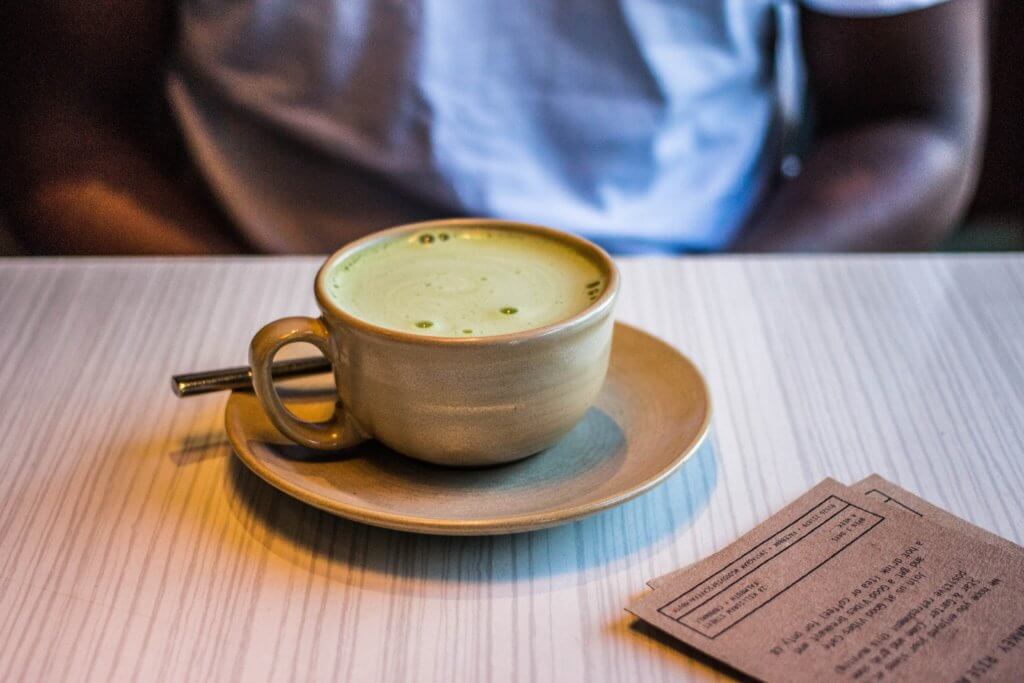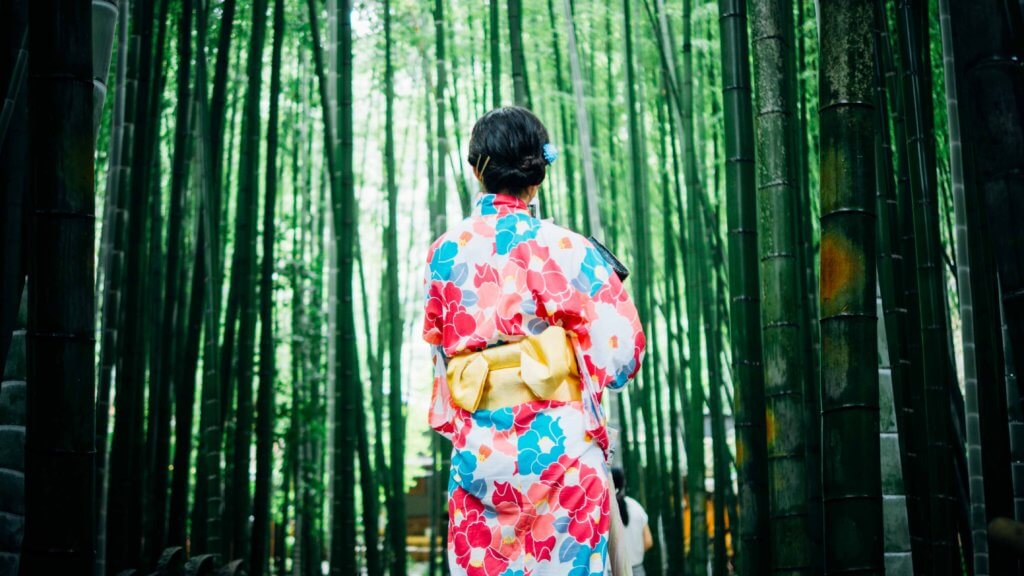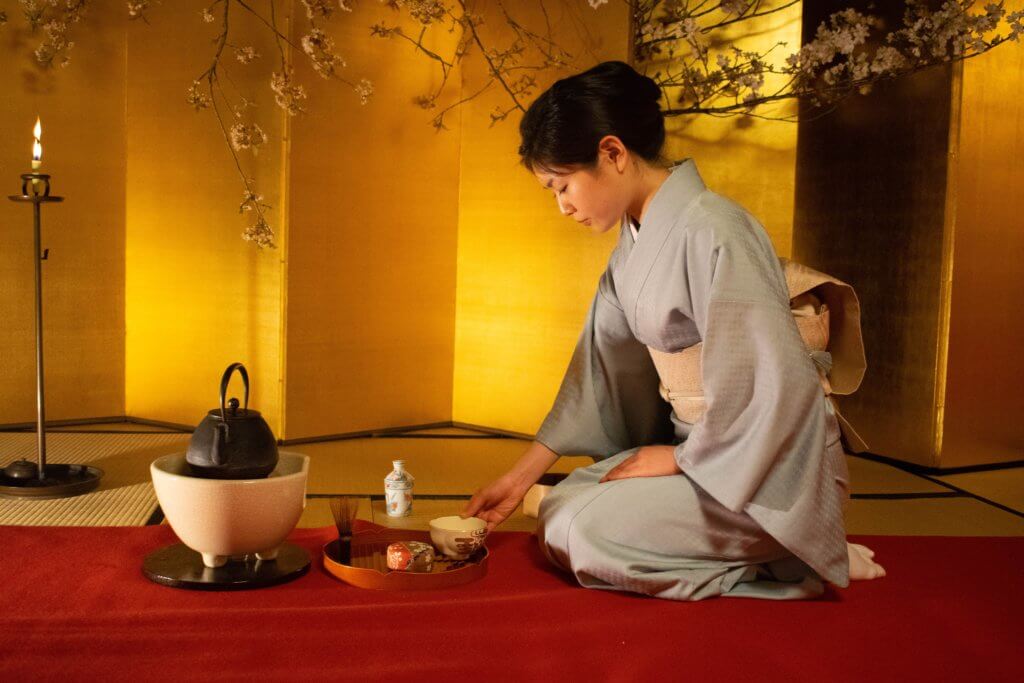
If you haven’t yet, please read the first part of the “I do, you do, Chadou – An Introduction to Japanese Tea Ceremonies” series, before continuing.
As I sit here drinking my matcha latte in a café in the furthest city away from Japan, I imagine I am there. I imagine I’m in the place and in the space where I can be pretty. Maybe it’s silk, organza, or ruffles mixed with pleats–a once in a lifetime outfit. My hair is coiffed and my nails bright enough to startle the stars.
I breathe cool, almost-fall air and take in the sight of maple leaves spreading across the ground like carpet. Sparrows are trilling about looking for worms and grub. The stones I walk over are cool and mottled with verdant moss. Encouraging my footsteps, the stones lead me to a small, wooden building, hidden by violets. I am here. I have arrived.

Now, where were we?
The building is a traditional Japanese tea room and it sits apart from the road, away from any other residence. Small and disarming in its size, the humble tea room contains a wealth of history and beauty concerning the tea ceremony. It is a barrier of sorts, too. One must stoop to enter the unique entryway, known as the nijiri-guchi. Not a typical door, but a small, humble one so close to the ground so as one needs to stoop, or bow, to enter. The physical and mental self is released as the space is entered; the items carried are forgotten and the contents of the mind reconsidered. The nijiri-guchi quiets and frees the mind of any baggage before one enters.
The room is austere, with natural light serving to highlight the typical elements of washitsu, or a traditional Japanese room. Sliding doors, tatami mats, a sunken hearth, and clay walls would typically be found here. Flowers or a hanging scroll may be placed in the alcove. The décor in washitsu can highlight the season and enhance the mood of the space. For instance, a maple branch may be placed in a brown-glazed vase underneath a scroll hinting at the subtlety and brevity of fall.

The room is small, allowing for but a handful of people at a time. The dynamic between host and guests is particularly important, and deepens the experience of chadou. The Japanese idea of hospitality, omotenashi, is thought to have originated from chadou itself. Omotenashi is the practice and idea of the host putting the needs of the guest before their own and, most importantly, where nothing is expected in return. It requires participation from both the host and the guest in order to produce a feeling of intimacy through nonverbal understanding. As guest and host come together in the space, they sit in a kneeling position known as seiza. Once seated, the rest of the ceremony continues on in silence. A pantomime of movements, the ceremony serves to honor the moments spent together and highlights the importance of every detail, for it is all these details combined that lead to the production of a single cup of tea.
Where do we go next?
Well, not all tea ceremonies are of the same length, nor do all ceremonies choose to have the same elements. Shorter ceremonies may not include meals, for instance. The details presented below are but only one example of one particular chadou.
Usually, after the host sits with the guest, charcoal is prepared in order to boil water on the hearth. Incense may be burned to add to the mood and to purify the space. Just as specific décor is chosen for enhancement of mood, so are the teacups, lacquerware, and other implements used throughout the ceremony. Admiration of the implements is encouraged and can give a sense of the ceremony’s history. Use of a particular artists’ work can also give insight into the mind of the host and what sort of world and mood they want to give to their guests. It’s like a mother choosing to drink from a mug her child made her for Mother’s Day instead of any other mug. The mom’s choice to use that cup conveys the sense of understanding of the time and effort put into making it, and she wants to show that sense of understanding to the child. This sensibility is an extension of omotenashi.
As this ceremony is explored to its finale in an upcoming article, other ways of creating mood, ambiance, and omotenashi will be further explored. While the nuances of chadou won’t be rigorously prodded, the major details and interesting bits will be looked at. Ways of bringing the sensibility of chadou into our own lives will also be seen.

Featured Sponsor - JAST
The sweetest romance and the darkest corruption, the biggest titles and the indie darlings; for visual novels and eroge, there's nowhere better.
Big thank you to our supporters
From their continous support, we are able to pay our team for their time and hard work on the site.
We have a Thank-You page dedicated to those who help us continue the work that we’ve been doing.
See our thank you page




